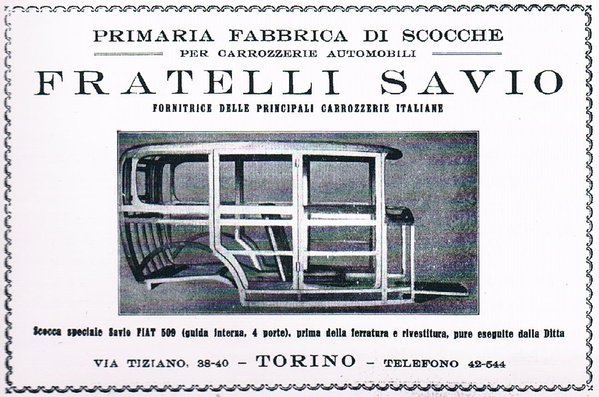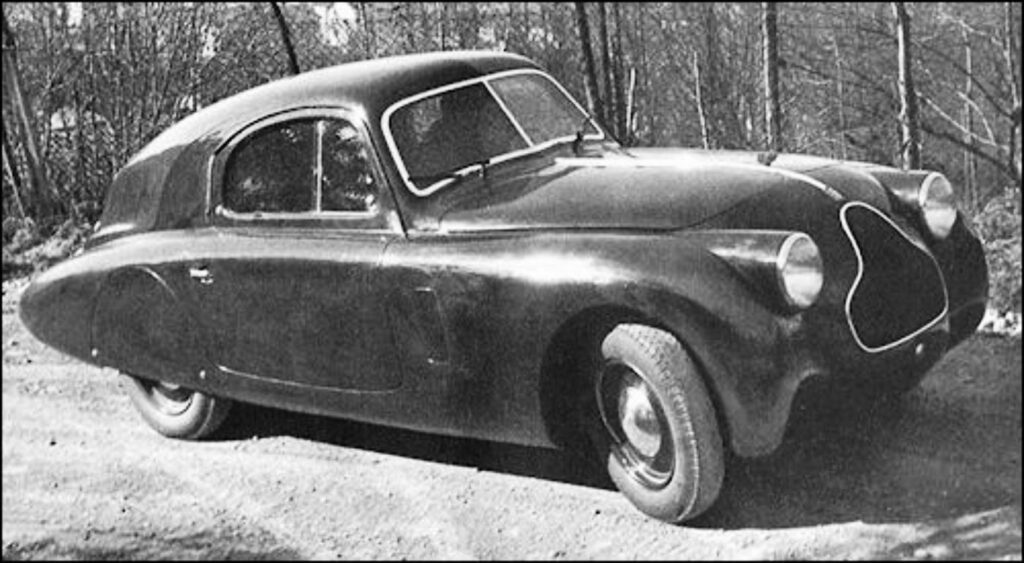
Carrozzeria Savio, founded in 1919 in Turin, is a name synonymous with Italian automotive craftsmanship. From its humble beginnings in the aftermath of World War I to its prominent role in industrial and automotive innovation today, the company’s journey reflects resilience, creativity, and adaptability. This article delves into the key milestones that define the rich history of Carrozzeria Savio.
The Early Years: Foundation and Growth
The Savio brothers, Antonio and Giuseppe, became apprenticies of Alessio in 1899. Subsequently they worked for Rothschild, Locati & Torretta, Taurus, Locati & Viarendo and Diatto In 1919, brothers Antonio and Giuseppe Savio, skilled craftsmen with over 20 years of experience in carriage manufacturing, established Carrozzeria Savio in Via Tiziano in Turin. Their close relationship with their former employer proved pivotal when they secured an initial order to outfit 900 Itala chassis. This significant contract set the stage for Savio’s early success.

Carrozzeria Savio quickly gained recognition in the burgeoning automotive industry. One of their early notable creations was a custom sedan with silent block technology for the now-defunct Fabbrica Automobili Giovanni Ceirano. This innovation was followed by collaborations with prominent Italian manufacturers, including Lancia, Alfa Romeo, OM, Isotta Fraschini, Ansaldo, and Fiat. The partnership with Fiat, which began in these formative years, would become a cornerstone of Savio’s legacy.
Among the 1930s highlights were the bespoke designs based on Fiat 508 and Fiat Ardita models. The 1938 Fiat 508C MM, a streamlined sports coupe, showcased Savio’s ingenuity. Its aerodynamic design earned accolades at the Mille Miglia, achieving a class win and 16th place overall, with an average speed of 112 km/h (70 mph). This innovative coupe set a precedent for modern automotive design.

World War II: Challenges and Adaptation
The outbreak of World War II marked a challenging period for Carrozzeria Savio. As the demand for civilian vehicles plummeted, the company pivoted to producing ambulance bodies. However, the war left its facilities in ruins. Antonio Savio, discouraged by the devastation, stepped away, leaving Giuseppe to rebuild the business under the name Stabilimento Savio Giuseppe Carrozziere Automobili.
Post-War Revival and Expansion
After World War II, Carrozzeria Savio embarked on a new phase of innovation, focusing on Fiat chassis to develop a wide range of models that blended style and practicality. Among the most distinctive creations were the Belvedere series, featuring an open soft top, and the Venilia, an inventive hybrid between a station wagon (Giardiniera) and a cabriolet. These designs showcased the company’s ability to adapt to post-war demands while maintaining its reputation for elegance. One of the most celebrated models of the era was the Landaulet, based on Fiat 1400 and 1900 chassis. This luxurious vehicle gained widespread acclaim at events such as the 1950 Concours d’Elegance in Rome and the Turin Auto Salons of 1950 and 1951, solidifying Savio’s status as a premier coachbuilder.

Savio collaborated with some of the most renowned designers of the time, including Giovanni Michelotti and Franco Scaglione. Scaglione’s work included a remarkable one-off coupé based on the Fiat 1100 TV chassis, a testament to the company’s dedication to exclusivity and cutting-edge design.
In 1954, Giuseppe Savio passed away, and the company transitioned under the leadership of his son-in-law, Alfredo Caracciolo. Caracciolo revitalized the business, steering it through a period of significant growth. In 1959, the company relocated to Moncalieri, gaining access to more modern facilities that allowed for increased production and innovation. During this period, Savio expanded its offerings with custom bodies for Fiat models, including the Fiat 1500 and 600, while continuing to produce ambulances.
Savio also embraced the leisure vehicle trend, introducing Spiaggetta cars that embodied the carefree spirit of coastal living. These small, open-bodied cars became symbols of the Italian Riviera lifestyle, combining Savio’s design expertise with a focus on fun and practicality. By the late 1950s, the company began incorporating stylistic influences from American and Space Age designs, integrating futuristic lines and details that reflected the cultural zeitgeist of the era.
Under Caracciolo’s leadership, Carrozzeria Savio entered the 1960s as a dynamic player in the automotive industry, balancing innovation, tradition, and a keen sense of style.
During the 1960s, Carrozzeria Savio flourished as a beacon of Italian automotive craftsmanship, blending tradition with forward-thinking innovation. This era saw the company deepen its collaborations with some of the most prominent designers of the time. Mario Revelli di Beaumont contributed a sleek Fiat 600 Spider design, while Pietro Frua added his interpretation of the model, showcasing distinct approaches to this compact yet stylish platform. Giovanni Michelotti worked closely with Savio, designing several refined coupé proposals based on the Fiat 2300 chassis, further cementing the company’s reputation for elegance and sophistication.
In addition to these designer collaborations, Savio began experimenting with conceptual vehicles that demonstrated a keen interest in the future of urban mobility. The Fiat Polis, unveiled at the 1964 Turin Motor Show, was one such example. Based on the Fiat 600 D chassis, the Polis featured sliding doors for easy access in tight spaces, a panoramic roof for increased visibility and spaciousness, and a minimalist design that embraced modernist aesthetics. Though it never went into production, the Polis highlighted Savio’s innovative spirit and its ability to push the boundaries of conventional automotive design.

Savio also expanded its portfolio in the leisure vehicle market during the 1960s. Building on the success of the Fiat 600 Jungla, an open-bodied vehicle perfect for outdoor activities, the company developed additional models such as the Savana and Albarella. The Fiat 500 Elegance, a sophisticated take on the Spiaggina concept originally built by Boano, was produced in small series and became another example of Savio’s ability to combine style and functionality.
A pivotal development during this decade was Savio’s entry into bus manufacturing, a sector that would become a cornerstone of its business operations. With a focus on both design and engineering, Savio applied its expertise to create robust and versatile bus bodies, laying the foundation for a segment that remains integral to the company’s activities today.
The Modern Era: Small Series and beyond
The 1970s marked a quieter chapter for Carrozzeria Savio as the company concentrated on perfecting its established focus on leisure vehicles. Models like the Autobianchi A112 Torpedo and Fiat 127 Albarella continued the legacy of the Fiat 600 Jungla, which had by then evolved into its own distinct model line. The Jungla name was retained for variants based on newer Fiat platforms, including the Fiat 126 and Fiat Panda, preserving its reputation as a versatile, open-bodied leisure vehicle. During this time, Savio also became a key subcontractor for Fiat, assembling military light vehicles. In 1976, they received their largest order ever to build the Campagnola.

The 1980s marked a resurgence of innovation and technical achievement for Savio. One of their most notable contributions during this time was their work on the bodywork for the legendary Lancia Delta S4, a car that gained fame for its dominance in rallying. The expertise demonstrated in this high-performance project garnered the attention of Italdesign, which entrusted Savio with the construction of the Aztec prototype in 1988. Two years later, Savio handled the limited production run of the futuristic Aztec, solidifying its reputation as a capable partner for cutting-edge automotive projects.
In 1987, Savio returned to its roots in leisure vehicles with the Fiat Freely, designed by former Pininfarina designer Paolo Martin. A spiritual successor to the Fiat 600 Jungla, the Freely was based on the Fiat Panda chassis and offered a modern interpretation of the open-body concept, catering to a new generation of outdoor enthusiasts.
The company expanded its operations in 1995 by acquiring the historic coachbuilder Boneschi through its holding company, Omnia, forming the Savio Group. This acquisition not only bolstered Savio’s capabilities but also reinforced its position as a significant player in the Italian automotive industry. The 1980s and 1990s demonstrated Savio’s resilience and adaptability, allowing the company to thrive in both niche markets and innovative collaborations.
Carrozzeria Savio Today
Today, Carrozzeria Savio specializes in industrial vehicle bodies, buses, ambulance outfitting, and commercial vehicle prototypes. While much has changed since its founding, the company remains a testament to Italian ingenuity and dedication to quality. Over a century after its inception, Carrozzeria Savio continues to shape the automotive industry with the same passion that Antonio and Giuseppe Savio embodied in 1919.
From elegant custom designs to rugged industrial applications, the history of Carrozzeria Savio is a celebration of Italian automotive heritage and innovation.




